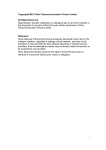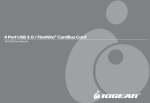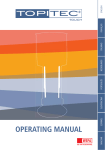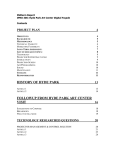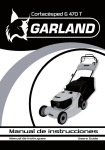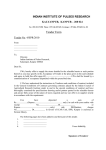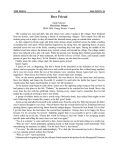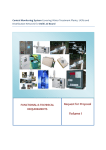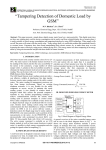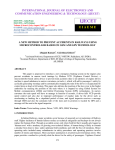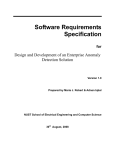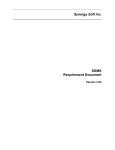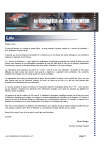Download CV English Sept 08-10:CV English Sept 08-2.qxd
Transcript
Vol. IX, Issue IX September 2008 Rs 50 9/2008 Visit us at www.consumer-voice.org C: 0177 HIGH PRECISION PRESSURE CALIBRATION OF DEAD WEIGHT TESTERS CALIBRATION FACILITY FOR PRECISE & INDUSTRIAL DEAD WEIGHT TESTERS (HYDRAULIC) HAS BEEN ESTABLISHED ACCREDITATION: 1. NABL AS PER ISO/IEC 17025 2. DGCA THE REFERENCE STANDARD HAS FOLLOWING SPECIFICATIONS & FEATURES REFERENCE STANDARD : Dead Weight Testers (Ruska, USA) PRESSURE RANGE : 0.5 bar g to 1000 bar g (Hydraulic) BEST MEASUREMENT CAPABILITY : ± 100 ppm TRACEABILITY : NIST, USA Built in (WINPROMPT) software for measurement of temperature of piston cylinder units, room temperature, relative humidity, Atmospheric in side the room, calculation of actual air density while calibration and applying the corrections of air density, head height & ‘g’ (local acceleration due to gravity), also provide support to precisely monitoring of the following for reference (DWT) & Under Calibration (DWT). • Sink rate of pistons • Float position of pistons • Balancing of the pistons OTHER FACILITY REFERENCE STANDARD : Dead Weight Tester (Ruska), USA PRESSURE RANGE : 1 bar g to 200 bar g (Pneumatic) BEST MEASUREMENT CAPABILITY : ± 100 ppm TRACEABILITY : NIST, USA Calibration of following Reference Standards/Industrial instruments can be undertaken. DWTs (Hydraulic), Digital/Analog hydraulic & pneumatic gauges, calibrators, pressure switches, transducers, transmitters, manometers (digital, vertical tube, U-tube, inclined tube) & sphygmomanometer. FOR DETAILS, PLEASE CONTACT Sh. D. Basu, Director, Tel. No.: 26386219 Fax.: 26384583, E-mail: [email protected] Sh. Gurmukh Singh, Group Head Cal (NE), Tel. No.: 26384400 Smt. Sunita Binji, Head (Customer Service Cell), Tel. No.: 26386206 Electronics Regional Test Laboratory (North) Govt. of India Ministry of Communications & Information Technology, STQC Directorate Okhla Industrial Area Phase II, NEW DELHI-110020 Contents COMPARATIVE TEST 6 Editor: Roopa Vajpeyi Chief Editor Prof PK Ghosh Mg. Editor Prof Sri Ram Khanna Exec. Director Bejon Misra COO Ashim Sanyal EDITORIAL Pooja Dogra Kanta Tyagi Arun Sagar 24 Manjari Khare LEGAL TECHNICAL Mona Varshney H Wadhwa KC Choudhary Mohd. Azim Khan MARKETING Pranay Sheth MANAGER-BRAILLE 28 34 Printed at Pearl Printers, B-186, Okhla Industrial Area Phase I, New Delhi-110020 For Gifts & Subscription-related enquiries, please contact: [email protected] 19 © consumer-voice.org All rights reserved. No article, story, test report can be reproduced from this magazine, without a written permission from the Editor. Material, test report, data from Consumer VOICE cannot be used for any marketing or promotional purposes. 16 26 Say goodbye to bulky consumer court judgement journals that arrive weeks after a judgement has been delivered. Now each and every consumer court judgement is going to be online for consumers to read Where innovation meets science From decoding the secrets of the Parsi community’s longevity to inventing drugs by studying the secrets of Ayurveda, Avesthagen is treading into some less-explored frontiers What to do after a road accident Here is a check list of what to do and what to avoid when you are in a road mishap A teacher with a difference More than the teacher’s academic qualifications, it is her sensitivity and commitment to the character-building work of children that matters. Consumer VOICE profiles one such teacher from Uttarakhand The silent killer: Hypertension Few people understand how serious the implications of variations in blood pressure are Your germ guide All that you didn’t know about germs FOOD Loving foods that love you back Here are some foods that will do you good and others that will make you overdraw on your energy reserves LEGAL FILE 22 Vodafone demonstrates ‘corporate greed’ 23 National Commission hauls up Passport Officer FINANCE All disputes are subject to the exclusive jurisdiction of competent courts in Delhi/New Delhi only. 31 Libel Insurance: The Consumer VOICE libel insurance policy extends to include typesetters, printers, distributors, co-publishers, and newspaper advertisements by VOICE. 36 Countering fake currency READERS PAGE Editor’s note: Consumer VOICE does not accept any corporate advertisements or advertorials for the magazine. This has been the magazine’s policy since the first issue was published in 1997 and it keeps our reportage unbiased and non-partisan. Consumer VOICE regularly publishes laboratory test results of product tests. These products are purchased from the retail market before being sent to an independent NABL-accredited laboratory for testing. Consumer VOICE magazine is now available in Braille. For details, contact: [email protected] CONSUMER VOICE 3 SEPTEMBER 2008 For subscription enquiries, call 011-24379076 Soft-touch consumer courts HEALTH 32 The views expressed in the magazine do not necessarily reflect those of the organisation, rather they are to be deemed as personal opinion of the author(s) concerned. Accuracy of 24 models of Blood Pressure Monitors tested TEACHERS DAY SPECIAL Dipendra Manocha Printed and Published by: Dr. K.L. Madhok for Voice Society, 441 (Basement), Jungpura, Mathura Road, New Delhi-110014 Ph.: 011-24379078-80 Telefax: 24379081 E-mail: [email protected] [email protected] Blood Pressure Monitors: checking on your health REPORT ONLINE HK Awasthi ACCOUNTS Ashutosh Massey Monender Singh Sanjay Kumar 14 Inverters: low on efficiency All the 9 brands of inverters tested by Consumer VOICE fail to meet national standards for ‘efficiency’ Editor’s mailbox Qatar Airways delays refund of cancelled air tickets Editor responds Dear Vishakhaben and Rameshchandra Ji, We see that you have written to Qatar Airways Ahmedabad office. You may also like to send a copy of each of your letter to the CEO of Qatar Airways at the airlines' Doha International Airport office. You can get their contact information on their website www.qatarairways.com. You can also post your user feedback on websites that feature complaints of air travellers. Unfortunately, there is no central agency in India that looks into air travellers' consumer complaints, so one has to take the PR exercise route. As a last resort, consumers can file a case in consumer courts. Dear Editor, We had cancelled our air bookings of a Qatar Airways (Ahmedabad-Doha-Newark-DohaAhmedabad) flight but have not received any refund of our money till date. We have been told by our booking agent that they have submitted related documents/material to Qatar Airways office in Ahmedabad. Qatar Airways claims to be a 'five star ranking' carrier but we are amazed at the negligence they have shown in their working. We would be happy to receive the refund at the earliest. Rameshchandra Pandya Vishakhaben Pandya Who regulates mediclaims? Dear Editor, Do we have any insurance-related norms, especially related to mediclaim and Third Party Administrators (TPAs)? Dr Desurkar.V.N. Pune Editor Editor responds Dear Dr Desurkar, The Insurance Regulatory Authority of India (IRDA) has the IRDA (THIRD PARTY ADMINISTRATORS̶HEALTH SERVICES) REGULATIONS, 2001, which governs clauses like the licensing of TPAs, code of conduct for TPAs etc. These are mainly in the context of the relation between the insurance company and the TPA. Mediclaims are the most controversial insurance problems and in thousands of cases are filed related to mediclaims in consumer courts every year. For details, you may visit www.irdaindia.org. Editor Washing machine shell problem Dear Editor, I have been using a Videocon washing machine (VNA811) for the past many years without any mechanical or electrical problems, but the outer shell of the washing machine has rusted and may collapse any time. I have complained to the local Videocon service centre and they said the shell cannot be procured. I also emailed a complaint to Videocon but have not received any reply from them despite reminders. SEPTEMBER 2008 Rtn PHF Koka Dayanand Nellore, Andhra Pradesh Editor responds Dear Mr Dayanand, It seems your complaint about Videocon washing machine's outer shell rusting away is not the only one. Our Technical Manager, Mr KC Chaudhary, faced the same problem with his Videocon machine that he had been using for several years. He had to find an alternate way of keeping his machine running by getting its rotting base removed by a local dealer who then put a new galvanised sheet in its place. The expense for a galvanised sheet is around Rs 800. The company is unlikely to provide you with a shell replacement once the warranty period is over. In fact, companies would rather have consumers scrap the old machines and buy new ones, to boost sales of course. Editor 4 CONSUMER VOICE “Today ‘green’ is a choice; Tomorrow ‘green’ will be a lifestyle” Editorial oward the end of the ‘Shakuntala’, a play by Kalidasa (which I incidentally taught to the final year University literature class during a course in classics of Ancient India), the hero Dushyanta offers this poignant selfanalysis: T 'Like someone staring at an elephant who says, "There is no elephant here," and who then, as it moves away, feels a certain doubt and later, seeing its footprints, is certain: "An elephant has been here"— such are the subtle workings of my mind.' Shakuntala stops to look back Raja Ravi Varma Or of any mind for that matter—the rueful king actually speaks for all of us. We almost always miss the elephant in front of us. By the time we make our retrospective deduction from the footprints, it's usually too late... New York Times reports: That private companies are proposing various measures to deal with the global warming issue, including attempts at "fertilizing" some parts of the oceans with iron, hoping to encourage carbon absorbing blooms of plankton. Meanwhile there is also talk about injecting chemicals into the atmosphere, placing sunreflecting mirrors into stationary orbit to stabilize the warming atmosphere of the planet. Clearly a broader discussion involving all stakeholders (most importantly, the general consumer fraternity across the planet) needs to be set in motion regarding the use of scientific and technological innovations to resolve the health issues looming over survival of life forms on planet earth. Questions about introducing nanotechnology and genetic engineering, robotics and other emerging technologies into everyday consumption routines, are still beyond the comprehension of the general class of consumers, who actually will be the most affected by all this. These newly-engineered systems with potential to impact our lives raise ethical questions, but only in hindsight as did the introduction of the atomic bomb in our lives. Experience should have taught us that it is almost impossible to turn back. Bill Joy cited the bomb in a famous 2000 article in 'Wired' in which he argued that some technologies are so dangerous that they should be 'relinquished'. He said that the latest technologies with 'unknown unknowns' pose a threat that is different than any technologies that have come before. Consumption-induced climate change is demonstrating the power that consumers have over the future of their survival and the problems that will inevitably be unleashed through the unconsidered introduction of any technology with short-term gains. The market of course is again the culprit, as usual, because it was 'Planktos', a US based concern that mooted the idea of fertilizing parts of North Atlantic with iron to produce carbon absorbing plankton blooms, that the company would market as carbon offsets. The world and its consumers have to be extremely conservative and cautious and not rush in to give unconsidered consent to ubiquitously introduced changes into their consumption choices. The debate on their behalf rages on with scientists like Mary Warnock who caution that ignorance and fear should not be allowed to dictate choices about which technologies are given the go ahead, and consumers should be educated to understand science, and appreciate technology's potential for good. However the other side of the debate questions a lay-person's ability to "recognize when we might be putting ourselves on a negative technological treadmill by moving in one direction rather than another?" There are social, ethical, environmental as well as health questions we should be paying attention to. Consumer VOICE , despite its phenomenal limitations and lack of various kinds of support, has always tried its humble best to alert, caution and educate its subscribers. A pro-active and participatory role is envisioned for consumers, because that is where the future of consumer education is headed. CONSUMER VOICE 5 SEPTEMBER 2008 (Roopa Vajpeyi) Editor Comparative Test Inverters: low on efficiency SEPTEMBER 2008 Electricity back-up has become a norm in every urban household. There is a space in the house reserved for stationing the inverter and its batteries. Branded inverters are supposed to deliver better-technology than the unorganised market inverters. There are no clear indicators however, of how long inverters will be able to run appliances on full load or exactly for how many hours will it recharge the battery. Consumer VOICE tests of 9 brands of inverters found that all the 9 brands of inverters failed to meet national standards for ‘efficiency’. This means that no inverter delivers as much power as it promises. This is one bit of information that no inverter manufacturer or advertiser would like to be made public. Yet, this is serious non-compliance of national standards and the government needs to make the ISI mark mandatory for inverters if that is the only way inverter manufacturers can be made to deliver quality products to consumers 6 CONSUMER VOICE ne beneficiary of the electricity supply deficit in India has been the inverter industry. Virtually every middle class home in urban India has an inverter and a battery or two working away, supplying power during power breakdowns and consuming electricity during charging time and also otherwise. An inverter is an electronic device, which changes direct current (DC) into alternating current (AC). The DC is generally supplied from a 12-volts lead-acid battery and changes it to AC voltage of about 230 volts. O Consumer VOICE tested 9 brands of 800 VA (and about) inverters and all brands were found to fail the national standard of ‘efficiency’. This essentially means that no inverter delivers on its promise of running ‘x’ number of appliances. If your inverter is supposed to run four tubelights, four fans and a television, the chances of it being able to support the full load are very slim. Inverters are also capable of ruining appliances as they run on ‘square wave’ or ‘quasi-sine wave’, Comparative Test The overall performance of the 9 inverter brands is very average. The best score (obtained by ‘Proview’) is a modest 68.42. Brand Score Rank Proview 68.42 1 66.10 2 (EPS 900 Galaxy) APC (MI800SQ) KEY FINDINGS • Inverters deliver a disappointing overall performance in Consumer VOICE tests. Even the top-performing inverters have average scores of 68.42 (Proview); 66.10 (APC), and 63.36 (Sukam). In the pure sine wave category, Genus gets a score of 62.91. Sukam (Cosmic) 63.36 3 Genus (HUPS800) 62.91 4 • An 800 VA inverter will not guarantee 800 VA of power as the efficiency of inverters tested was found to have efficiency between 60.80 to 80.82%. All 9 brands did not measure up to national standards in this regard. Luminous 60.67 5 • Only one brand: ‘Genus’ is a pure-sine wave inverter, among the brands tested. True Power 59.69 6 58.87 7 (pure sine wave) Hyundai 58.69 8 • Inverters consume power even when batteries are fully charged and there is no connected load. This energy consumption is between 108.35 to 188.37 watts. There is no way you can call an inverter an energy-efficient or environmentfriendly appliance. Microtek 55.30 9 • None of the 9 brands of inverters tested by Consumer VOICE had ISI certification. (CW018 Pluto) Intex (Classic) (UPSEB 850) Note: Score of 800 VA inverters as obtained in the comparative tests conducted by Consumer VOICE. For details, see pg 12 which are detrimental to the longevity of electrical appliances. ‘Pure sine wave’ inverters are available but they are more expensive variety of inverters. Brands like Sukam and Microtek have their pure sine-wave variety of inverters available. Inverters: low on ‘efficiency’ The critical performance factor for inverters is whether they are actually able to support the running of as many appliances as they promise. ‘Efficiency’ is the ratio of power output to power input, expressed as a percentage. No inverter brand will make this actual performance information public and no dealer is likely to reveal that buying an 800 VA inverter is no guarantee that you will be able to run as many electrical appliances as the inverter claims. So for all practical purposes, you can forget about running four fans and four tubelights simultaneously on your 800 VA inverter. assured of inverters that are worth the money spent on their purchase. Delivering the right voltage An inverter converts Direct Current (DC) into Alternating Current (AC) to a voltage of about 230 volts. When the inverter runs, it is desirable that it should maintain a steady voltage of around 230 volts. The national standards allow a deviation of 5% from the Consumer VOICE urges the government to make the ISI Mark mandatory for inverters. Even though standards require inverters to have at least 85% efficiency, manufacturers have not bothered to meet this requirement. This is because they are not answerable to the government standardisation agencies as inverters do not support the ISI mark. Had the ISI mark been mandatory for inverters, consumers would have been CONSUMER VOICE 7 SEPTEMBER 2008 So when Consumer VOICE tested inverters, we wanted to find out if an 800 VA inverter actually delivered as much power, which practically means what is the efficiency percentage of the inverter, or how much energy is lost by the inverter. We had the Bureau of Indian Standards (BIS) requirement of an inverter delivering at least 85% efficiency as the benchmark and we found that even the top-performing inverter (APC) in this test parameter could deliver only 80.82% power. The rest of the inverters had even poorer performance, ranging between 60.80% (Microtek) to 76.90% (True Power). Comparative Test rated voltage. The output voltage tends to be on the higher side when there is no load on the inverter (for instance, when the mains power supply is off and the inverter is running but no appliances are switched on), than when there is load on the inverter. Consumer VOICE tests found that except for the brand ‘Proview’, all brands delivered excessive voltage. This has the potential to damage the appliances run on inverters, particularly when there is less load on inverters during a power failure. Battery charging time Excessive and frequent load shedding is not uncommon in India. There are towns and cities which witness power cuts every few hours. In such a scenario, it becomes imperative that the battery should charge fully within the time that there is mains supply (electricity supply from the grid). However, an inverter that charges batteries super-fast is not exactly a good performer as it can shorten the life of the battery. Similarly, an inverter that takes a long time to Inverters: India’s unsure answer to power cuts This is a typical Indian scenario. The auto-industry is booming because there is no effective public transport system. Water-pumping motors are bought everyday because water supply is erratic, and inverters and gensets are an industry unto themselves because urban Indians have the costliest of gadgets but no electricity to run them. These products are so much a part of our lives that it does not even occur to us that there is something wrong with our service and supplies sector. SEPTEMBER 2008 If there are systemic shortcomings, consumer apathy and environmentalinsensitivity cannot be discounted from the picture either. Wealthy people who can afford to install gensets to run everything from air conditioners to refrigerators, don’t spare a thought for the noise and air pollution caused by these machines that only inflict damage on the environment, and destroy neighbourhood peace. Consumer expectation and desire for luxury has meant that not just the basic tubelights and fans, inverters (3KVA to 10KVA) can now also run air conditioners. However, this also means spending thousands of rupees on the inverter and its several batteries. Once a product category comes into existence, it brings with it, its concomitant problems of hazardous ingredients, disposability of trashed machines, maintenance, sub-standard service and consumer complaints. Inverters (and batteries), especially require an intensive long-term maintenance period. Inverter and battery manufacturers make tall promises about the technical superiority and longevity of their product and superlative backup service, but once the product has been purchased, the consumer is faced with poor after sales-service and nagging product performance problems. More than the inverters, batteries are a constant source of misery as there is absolutely no telling how long they will last or how soon they will pack up. 8 CONSUMER VOICE Consumer VOICE urges the government to make the ISI Mark mandatory for inverters. Even though standards require inverters to have at least 85% efficiency, manufacturers have not bothered to meet this requirement. This is because they are not answerable to the government standardisation agencies as inverters do not support the ISI mark. Had the ISI mark been mandatory for inverters, consumers would have been assured of inverters that are worth the money spent on their purchase. charge battery can mean that the batteries are never charged fully when its time for the next power cut. Since batteries are more expensive than the inverter itself, it is important to assess how exactly an inverter affects the batteries. Consumer VOICE laboratory tests found that ‘Sukam’ takes the longest time to charge batteries (06.25 hrs) and ‘Proview’ the least (02.37 hrs). The optimal battery Comparative Test The battery problem With millions of inverters being sold in India annually, one can only imagine how many units of lead acid batteries find their way into Indian homes. Batteries are also the components that are replaced every year or two even when the original inverter continues to run. Placing a lead-acid battery inside living quarters can be dangerous as inhalation of battery fumes can be hazardous to health. The internal components of the battery include lead and liquid electrolyte. Electrolyte is corrosive (sulphuric acid) and contact can cause severe skin irritation and chemical burns. Inhalation of lead dust or fumes may result in headache, nausea, vomiting, arm and joint pain etc. Prolonged exposure can lead to central nervous system damage, kidney dysfunction, reproductive system disturbances, and other serious conditions. Once a battery becomes useless for inverter operations, it is often traded in for a new battery. The old battery becomes scrap and lead is recovered in a crude manner. The top portion of the battery is removed and the acid drained for neutralisation. In India, batteries are often broken by hand, exposing the labour to grave health hazards. Consumers know little about this fact and no questions are asked when a battery is summarily disposed off from the home. Change-over time In an inverter, there is a certain timelag between the time that the mains go off and when the inverter starts to supply battery power. The lowest change over time was that of Sukam (6.40 miliseconds) and the longest changeover time was taken by APC (138 miliseconds). The humming sound charging time was taken as a mean of maximum and minimum charging time of all brands. Consumer VOICE noted the maximum ‘total harmonic distortion (THD)’ in ‘APC’. The electricity cost of running an inverter Have you ever wondered why despite regular power cuts, your electricity bill still does not seem to climb down? Your inverter could be a culprit in this regard. An inverter not only consumes electricity while recharging the batteries but also when the batteries are in fullycharged condition. ‘Idle power’ (stand-by mode) is the power consumption of the inverter when it is on, but no loads are running. It is "wasted" power, so if you expect the inverter to be on for many hours during which there is very little load (as in most residential situations), you want this to be as low as possible. Consumer VOICE tested all inverters for their ‘input power’ performance during fully-charged battery condition, which means CONSUMER VOICE 9 SEPTEMBER 2008 Most inverters these days use two modes for battery-charging: “boost” and “trickle-charging”. In the ‘boost’ mode, the battery is boosted with heavy charging current and brought to about twothird of charge level, before it switches to the ‘trickle’ mode for remaining charge. When appliances are run on inverters, they tend to produce a humming sound or a drone that is indicative of the fact that the inverter is ‘square wave’ (see box ‘The difference between ‘pure sine wave’ and ‘square wave’’ on pg 10). There are electronic noises created by various circuits of inverters which are known as ‘harmonic distortion’. The sum total of this electronic noise (or interference) is known as ‘total harmonic distortion’. ‘Genus’, a pure sine-wave inverter, was the only inverter to conform to national standards insofar as the electronic noise distortion is considered. Comparative Test The difference between ‘pure sine wave’ ‘square wave’ and Inverters are generally of three basic types: ‘sine wave’, ‘modified sine wave’ and ‘square wave’. This distinction refers to the quality of the electrical output of the inverter and the types of electrical devices the inverter can successfully operate. Electricity that you receive from your local electrical utility company is sine wave and is the best form of electricity. Good sine wave inverters are starting to show up on the market but are relatively expensive. Some inverters produce "cleaner" power than others. A sine wave has a naturally smooth geometry, like the track of a swinging pendulum. It is the ideal form of AC power. The utility grid produces sine wave power in its generators and (normally) delivers it to the customer relatively free of distortion. A sine wave inverter can deliver cleaner, more stable power than most grid connections. How clean is a "sine wave"? The manufacturer may use the terms "pure" or "true" to imply a low degree of distortion. The facts are included in the inverter's specifications. Total harmonic distortion (THD) lower than 6 percent should satisfy normal home requirements. Look for less than 3 percent if you have unusually critical electronics, as in a recording studio for example. A "modified sine wave" inverter is less expensive than a “pure sine wave” one, but it produces a distorted square waveform that resembles the track of a pendulum being slammed back and forth by hammers. In truth, it isn't a sine wave at all. Engineers prefer to call it "modified square wave." The "modified sine wave" has detrimental effects on many electrical loads. It reduces the energy efficiency of motors and transformers by 10 to 20 percent. The wasted energy causes abnormal heat, which reduces the reliability and longevity of motors and transformers and other devices, including some appliances and computers. SEPTEMBER 2008 About 5 percent of household appliances simply won't work on modified sine wave power at all. A buzz will be heard from the speakers of nearly every audio device. An annoying buzz will also be emitted by some fluorescent lights, ceiling fans, and transformers. Alternating current (AC) has a continuously varying voltage that swings from positive to negative. This has great advantages in power transmission over long distances. Power from your power company is carefully regulated to be a perfect sine wave, because that is what naturally comes out of a generator, and also because sine waves radiate the least amount of radio power during long distance transmission. 10 CONSUMER VOICE electricity consumption during ‘stand by mode’—when the batteries are charged, there is power from the mains, but the inverter is still consuming power. ‘Proview’ had the most disappointing performance as its power consumption was 188.37 watts. ‘Sukam’ got the top-ranking in the stand-by power consumption test—with its power consumption being 108.35 watts—the least among the 9 inverters tested. Cooling of the inverter In an inverter, there are several sub-assemblies that heat up during operations and it is desirable if the parts have a cooling mechanism to keep the machine working at an optimal level. All inverters provide for cooling. Some have an in-built fan for this purpose while others provide only for vents. The in-built fan cooling system is any day better and more efficient than natural (vent) cooling. Of the 9 inverters tested by Consumer VOICE, only ‘APC’, ‘Genus’ and ‘Sukam’ had forced cooling. Inverter and battery, tricky combination Anybody who has bought an inverter (and battery) knows how tricky the situation can be when you are forced to buy an inverterbattery combo. When you DON’T buy the battery recommended by your inverter manufacturer, the problem can be still more complex because when the inverter or the battery malfunctions, each party blames the other for deficiency in service, and the consumer problem remains unresolved. Batteries are often more troublesome than inverters themselves. They drain out quickly (sometimes within the one year warranty period), don’t give com- Comparative Test plete charge, and have to be replaced frequently, putting financial burden on the consumer. Even the most trusted branded batteries have a litany of complaints against them about poor performance of the product. Battery warranty is another area of concern. Taking care of your battery • Tubular batteries are better than the standard batteries as they can store more charge and have longer life. • For an 800 VA inverter, choose a 21 plate battery, or more precisely, a 135 Ah capacity battery. • Top up the battery with distilled water if the electrolyte level goes down. • Keep battery terminals greased and clean of dust. If corroded, wash with hot water, clean to dry. • Use a plastic tray or a wooden plank on which the battery should be placed. Putting a wooden plank under a battery actually increases battery life. Besides, when battery leaks, it can permanently spoil the flooring. Manufacturers respond No manufacturer takes kindly to the fact that unpalatable truths about its product are being made public. Inverter brands are no different. When Consumer VOICE sent test results of Microtek inverter to the manufacturer—Microtek International Private Ltd—they responded by saying that they were prohibiting the magazine from publishing the test report. Consumer VOICE responded to their letter point by point and since then, has sent them three reminders to which there has been no reply by Microtek. Su-kam had some remarks on results of test parameters like ‘efficiency’, ‘input DC voltage’, ‘battery full voltage’, ‘AC voltage’, and ‘frequency waveforms’. Consumer VOICE sent a clarification on all the technical points raised by Su-kam. How we test Consumer VOICE shortlisted 9 most popular brands of 800 VA inverters after a four-metro cities’ market survey of inverter brands most sold in the respective regions. The 800 VA category was chosen as it is the most sold inverter power category. For those brands which did not have an 800 VA capacity model, the closest capacity model was chosen. The testing was done in an independent laboratory according to the national standard: IS 13314:1992 and other related documents. Cost of running an Inverter with fully-charged battery during no-load condition Brand Input power during fully charged condition in Watts Power consumption in idle state (no load connected) in KW Cost per day in Rs Monthly cost in Rs APC 117. 49 1.71 8.55 256.5 Genus 183. 65 3.044 15.22 456.6 Hyundai 113. 91 2.002 10.01 300.3 Intex 117. 88 1.822 9.11 273.3 Luminous 143. 75 2.219 11.09 332.7 Microtek 139. 22 2.269 11.34 340.2 Proview 188. 37 3.245 16.22 486.6 Sukam 108. 35 1.446 7.23 216.9 True Power 174. 64 2.878 14.39 431.7 Highest running cost Least running cost CONSUMER VOICE 11 SEPTEMBER 2008 Cost of Power consumption per day during idle state/standby when battery is fully charged and inverter waiting to cut in = Power consumption in idle state X 24 h – (Discharging time + Charging time) X Tariff. Note: kilowatt (kW) is equal to one thousand watts cost of electricity taken as Rs 5 per unit. Average battery discharge time = 4 hrs per day. As an ideal case, the per day charging cost (depending upon different brands) is taken as at Rs 10 (for 2 kWh power consumed). The running cost of an 800 VA inverter will be between Rs 516 and Rs 786 per month. 12 CONSUMER VOICE 5 10 5 35 5 3 3 3 4 5 5 100/97 No load test Output test (voltage regulation) Frequency test Efficiency test Harmonic contents Battery charging time Changeover time (Inverter Mode) Changeover time (UPS Mode) Output waveform Overload capacity Input power during fully-charged conditions 68.42 3.35 2.4 - 2.54 1.8 2.28 23.04 4.98 5.7 3.5 5 5 66.10 64.12 3.33 3.95 2.4 - 1.2 2.65 1 21.63 4.99 4.56 3.31 5 5 3.1 2 800 7704/ 5200 APC INVERTER 58.69 56.83 3.4 2.57 2.4 - 2.65 1.85 1.13 18.48 4.1 2.46 2.29 5 5 3.5 2 800 6850/ 4950 HYUNDAI 63.36 63.36 3.5 1.83 2.4 2.64 3 1.8 1.31 21.55 4.89 2.44 2.6 5 5 3.4 2 800 7350/ 5200 SUKAM * Sine wave Inverter Rating: >91 – Very good , 71-90 – Good , 51-70 – Average , 31-50 – Poor , upto 30 – Very Poor Note: The above data is based on the actual performance of brands tested in an independent laboratory by VOICE. A detailed test programme, with assigned weightage for each parameter, was devised by VOICE for the purpose. Score in percentage 100 66.37 5 Climatic test TOTAL SCORE 2.38 5 High voltage & insulation resistance 2.4 5 Technical features 2 900 5550/ 4750 PROVIEW 2 Weightage General features Capacity in VA Brand 60.67 60.67 2.81 2.75 2.4 2.74 2.81 2.74 1.39 19.03 4.92 1.86 1.72 5 5 3.5 2 800 6875/ 5100 LUMINOUS 59.69 59.69 2.25 2.32 2.4 0.83 2.2 2.59 1.28 21.67 4.26 2.5 2.09 5 5 3.3 2 810 6235/ 4750 TRUE POWER 58.87 58.87 3.33 2.54 2.4 1.6 2.25 2.82 1.24 19.58 4.92 1.42 1.67 5 5 3.1 2 800 6800/ 4900 INTEX INVERTER Cum UPS 55.3 55.3 3.06 1.6 2.4 1.57 2.63 2.36 1.34 16.03 4.91 1.34 2.46 5 5 3.6 2 850 7800/ 5100 MICROTEK COMPARATIVE PERFORMANCE OF INVERTERS/INVERTER-CUM-UPS MRP/ Retail Price (Rs) Parameters SEPTEMBER 2008 62.91 62.91 2.03 2.58 4 3 2.45 2.48 3.66 17.75 4.53 3.46 1.47 5 5 3.5 2 800 100/ 5800 GENUS* Comparative Test Comparative Test Blood Pressure Monitors: Checking on Your Health Why you need a Blood Pressure Monitor at home • Experts: All with hypertension should have home blood pressure monitors • Home monitoring can give more accurate readings, avoiding stress of doctor visit • Closer monitoring allows doctors to fine tune medicines, as with diabetics. When evaluating home blood pressure monitors, it is important to consider both usability and accuracy, with accuracy of the reading being the most important consideration. International Consumer Research and Testing (ICRT), a Europe-based product testing organisation tested 24 samples of blood pressure monitors to check them for a range of parameters— like clinical measuring accuracy, memory, alarms, power supply, cuff circumference, labelling and even environmental disposability. Blood Pressure Monitor Accuracy SEPTEMBER 2008 The apparatus of the 24 models of BP monitors were tested for accuracy by ICRT. A jury consisting of 32 test persons, also including sufferers of high blood pressure and diabetes, was used to test each blood pressure monitor. Each monitor was used on each test person. The ‘Boso’ brand of BP monitors fared well as two of its models (Boso Medistar S and Boso Medicus Family) got the top scores of 3.68—ahead of all the other brands. On the other hand, ‘Rossmax ibp A40’ BP monitor was found to be least accurate—the monitor getting a score of 1.96 in the monitor accuracy test. 14 CONSUMER VOICE Home blood pressure monitors are especially important for the elderly, pregnant women, diabetics and people with kidney disease. Experts recommend that if you are buying one, choose one with an upper-arm cuff, not a wrist or finger device, as they can be most inaccurate Some of the points for which BP monitors were tested for accuracy were: measuring range, technical measuring accuracy, clinical measuring accuracy, measuring duration, and cuff pressure. Ease of using a Blood Pressure monitor The user manual instructions of a blood pressure monitor, changing and checking of battery, displays and controls, and environmental disposability of each of the 24 BP monitors were rated according to how easy it was for a consumer to use these features. The Beurer BM 16 came out as the most easy-to-use BP monitor. The Best Rated BP Monitors In the overall ranking of BP monitors, ‘Aponorm by Microlife’ and ‘Boso Medicus Family’ got the top honours. About Blood Pressure Monitors Electronic/digital blood pressure monitors for home use are either semiautomatic manual-inflation (you squeeze the bulb to inflate the cuff) or automatic-inflation. Automatic monitors have everything contained in one unit, so it's easier to handle than systems with a separate gauge and stethoscope. Most home blood pressure monitors are very portable and have a D-ring cuff for one-handed application. The cuff may fit around the wrist or arm. More expensive monitors have automatic inflation and deflation systems, along with large, easy-to-read digital displays and error indicators, reading printouts and built-in pulse (heart rate) measurement. Most home blood pressure monitors measure either at the upper arm or wrist, though a few are also finger models. Experts say that those that measure pressure at the upper arm are best, as there is too great a chance for error when blood pressure is measured elsewhere. Types of Blood Pressure Monitors • An aneroid monitor • A digital monitor • Finger/wrist monitor blood pressure The aneroid monitor has a dial gauge that is read by looking at a pointer. The cuff is inflated by hand, by squeezing a rubber bulb. Comparative Test HOW WE TEST The tests of BP monitors were conducted by International Consumer Research and Testing (ICRT), based in Europe. ICRT is an association of 37 consumer organisations from 33 countries worldwide. It aims to promote co-operation in consumer research and testing among its members and other organisations concerned with consumer matters. Digital monitors have either manual or automatic cuffs. The blood pressure reading flashes on a small screen, and is therefore easy to read. Some electronic monitors even give you a printout of blood pressure reading. The digital monitor is easier to use than an aneroid one. It has a gauge and stethoscope as one unit, an error indicator, and deflates automatically. This device is good for hearingimpaired patients, as there is no need to listen to heart sounds through the stethoscope. racy is changed by body move- However, this equipment has some disadvantages too. The accu- expensive compared to other mon- ments or an irregular heart rate. The monitor also requires batteries, and some of its models are designed for use only with the left arm. Finger/wrist monitors, as tests reveal, do not measure blood pressure accurately. Also, they are extremely sensitive to position and body temperature, and more itors. PERFORMANCE RATING OF BLOOD PRESSURE MONITORS Brand Price in Rs* Blood Pressure Measurement 65 25 10 1617 2.37 3.41 3.54 2.37 Weightage in % AEG BMG 4906 Ease of Use User Information Overall Grade Beurer BM16 3364 2.18 4.34 3.97 2.18 Boso Medistar S 1940 3.68 3.71 3.90 3.71 Happy Life 1810 2.42 3.64 3.98 2.42 Omron M9 Premium 6470 2.44 3.94 4.07 2.44 Omron R4 Plus 2590 3.34 3.99 4.03 3.57 Panasonic EW3006 2588 3.51 3.87 3.82 3.63 Sanitas SBM06 1300 2.14 3.18 3.39 2.14 Sanoquell 341 1300 3.56 3.42 3.75 3.54 Visomat Comfort III 3752 2.54 4.00 3.45 2.99 Weinberger KP 6240 840 2.71 3.56 3.58 3.01 Aponorm by Microlife 5500 3.66 4.10 3.57 3.76 Beurer BC20 3040 2.94 3.39 3.65 3.12 Boso Medicus Family 5175 3.68 3.98 3.66 3.76 Rossmax ibp A40 1.96 3.03 3.09 1.96 Health & Life alvita HL 168 2.64 2.97 2.35 2.69 Dupont Poignet - C3 3.66 3.81 2.75 3.61 Microlife Magnien BP 3.65 5.50 2.40 7760 3.19 4.26 4.29 3.57 Spengler TB-101 4400 2.32 3.95 2.80 2.32 3.15 4.00 3.89 3.44 2.40 4.20 4.11 2.40 Omron M3 Intellisense Medisana HGV 3880 Performance Grading: Excellent 4.6- 5.5, Very Good 3.6- 4.5, Good 2.6- 3.5, Average 1.6- 2.5, Poor 0.6-1.5 Note: The results are based on an international ICRT test, therefore some models may not be available in Indian markets. * Equivalent prices in Europe CONSUMER VOICE 15 SEPTEMBER 2008 2.40 Omron M6 Comfort Health Hypertension The Silent Killer: The first thing that we need to understand is that each of us has and needs blood pressure. Without it, blood would not be able to circulate through our body. And if we did not have circulating blood, how would our vital organs get the oxygen and food that they need to work? Therefore, it is important for us to know what blood pressure is and how to keep it at a healthy level. When the heart beats, it pumps blood to the arteries and creates pressure (blood pressure) in them. This pressure results from two forces. The first force is created as blood pumps into the arteries and through the circulatory system. The second is created as the arteries resist the blood flow. How is Blood Pressure Measured? SEPTEMBER 2008 Blood pressure is measured in millimeters of mercury (mm Hg). Systolic pressure is the blood pressure when the heart is beating and diastolic pressure is the blood pressure when the heart is at rest. What is Normal Blood Pressure? The human heart beats about 60 to 80 times a minute under normal conditions. Our blood pressure 16 CONSUMER VOICE rises with each heartbeat and falls when our heart relaxes between beats. Blood pressure can change from minute to minute, with changes in posture, exercise or sleeping, but it should normally be less than 120 (systolic)/80 (diastolic) mm Hg for an adult. According to the World Health Organization, “Ideally blood pressure should not be greater than 115/75mm of Hg”. Each rise of 20mm of Hg systolic blood pressure or 10mm of diastolic blood pressure above 115/75 doubles the risk of heart and blood vessel disease. What is High Blood Pressure? In an adult, high blood pressure (or hypertension) is defined as blood pressure greater than or equal to 140 mm Hg systolic pressure or greater than or equal to 90 mm Hg diastolic pressure. A healthy person’s arteries are muscular and elastic. They stretch when the heart pumps blood through them. How much they stretch depends on how much force the blood exerts. Blood pressure that stays between 120–139/80–89 is considered prehypertension and above this level (140/90 mm Hg or high- “I’m not well today. I have BP,” is a common and increasingly frequent statement made by people– young, middle aged, and old alike—the world over. Very few, however, really understand what BP or ‘blood pressure’ actually means, or how serious are the results of variations in blood pressure er) is considered high (hypertension). Doctors usually take several readings over a period of time before deciding whether a person’s blood pressure is high or not. Did You Know? High blood pressure is the No.1 risk factor for death and disability in the world. 7.1 million deaths worldwide are due to high blood pressure. Uncontrolled high blood pressure can lead to: • heart attacks • paralytic strokes • heart failure Health • eye problems • kidney dysfunction • High blood pressure (hypertension) was listed on death certificates as the primary cause of death of 54,707 Americans in 2004. It was listed as a primary or contributing cause of death in about 300,000 of the more than 2.4 million U.S. deaths in 2004. • About 73 million American adults age 20 and older have high blood pressure. • Nearly one in three U.S. adults has high blood pressure. • More than 40 percent of African Americans have high blood pressure. • 28 percent of people with high blood pressure don't know they have it. What Causes High Blood Pressure? A number of things could cause high blood pressure. Such as: • Tablets–birth control pills, cold remedies, decongestants, pain relievers • Kidney diseases • Adrenal diseases • Thyroid diseases • Abnormal blood vessels • Pre-eclampsia, or a significant increase in blood pressure during the last 3 months of pregnancy • Use of illegal drugs, e.g. cocaine and amphetamines. Are There Any Symptoms of High Blood Pressure? • Dizziness Nose bleeds Excessive perspiration Muscle cramps Weakness Frequent urination Rapid or irregular heartbeat (palpitations). Am I at Risk of High BP? Yes, If: • It runs in your family. • You are a young adult or early middle-aged male (women are less at risk, and more so after menopause) • You are obese, esp. with a body mass index (BMI) of 30.0 or more • You eat too much salt • You drink too much alcohol • You follow an inactive lifestyle • You are constantly under stress. But hold on! That’s the bad news. The GOOD news is that all these things are within your control, and once you start working on them with a strong will power, your blood pressure will rapidly move from high to normal. Better still, if you are not yet at risk on account of any of these factors, avoid them like the plague. Prevention is ALWAYS better than cure. What Medication Does High BP Require? Generally, the following types of medication are first chosen to control high BP: • Diuretics: These act on kidneys to help the body get rid of sodium and water, reducing blood volume. • Beta-blockers: These block the effects of certain adrenaline-related chemicals, so that your heart can beat more slowly and with less force. • Angiotensin-converting enzyme (ACE) inhibitors: These help to relax blood vessels by blocking the formation of a naturally occurring chemical that narrows them. • Calcium antagonists: Also called calcium channel blockers, these help to relax the muscles of blood vessels. What Should I Eat? More of fruits, vegetables and low-fat dairy foods. Include whole grains, poultry, fish and nuts in your diet. Less of fats, red meats, sweets and sugared beverages. Remember the good old saying: We are what we eat! Tips for monitoring • If you are buying a BP monitor, buy one with an upper-arm cuff, not a wrist or finger device. • The cuff size: Your doctor, nurse or pharmacist would be able to tell you the cuff size you need, depending on the size of your arm. If your cuff size is wrong, your blood pressure readings will also be wrong. • Take two or three readings at a time, one minute apart, while sitting. • Readings should be taken at the same time each day for a week. • Bring the device to your next doctor visit to compare readings. • The numbers on the monitor should be easy for you to read. • Stethoscope: If you are using one, make sure you can hear heart sounds through it. • Cost: Look around and check out your options. The most expensive is not necessarily the best. CONSUMER VOICE 17 SEPTEMBER 2008 High BP is called the ‘silent killer’ because you can have it for a long time without being aware of it. Most people have no telling symptoms. However, there are warning signs you should look out for, e.g.: • Headaches • • • • • • Teachers Day Special teacher with a difference A teacher is a child's link to the rest of the world. The first lessons in sincerity and deportment are picked up by children from their teachers, who are their role models for life. Sadly, in the rural areas of India, a majority of government teachers show little interest in their jobs, or even realise that they are responsible for making or marring hundreds of impressionable minds. A India may be zooming ahead in information technology but one of the pillars of India's development all day long to make ends meet. In such a situation, children need to be nurtured still more carefully, and schools need to act as agents of change and provide therapy to children whose lives are rocked by familial and economic subjugation. While it is common to come across school teachers sending their students off to fetch gutka packets from the local shops and make students sit out in the sun instead of the classroom; it is very rare to chance upon a young teacher who takes her “Crowded classrooms and half-day sessions are a tragic waste of our greatest national resource—the minds of our children” —Walt Disney still remains the school education edifice. Sadly, the focus of the people remains on schools in urban India, whereas their rural counterparts lag behind, with minimal infrastructure and even less attention from the various stakeholders. Deep Shikha Harbola is a young 25-year old teacher who has chosen to teach English in the remote town of Barakot in Champawat-part of Pithoragarh district that borders Tibet. "For six months, I was the only female teacher in the school and my students would run away from the class even when I would be there", reveals this gutsy English teacher. Deep Shikha began by making sure that her CONSUMER VOICE 19 SEPTEMBER 2008 The Himalayan state of Uttarakhand is one such state that could be shown concern by the government, as school education there needs to be uplifted. In the far-flung areas of the state, there are pockets where alcoholism in the male population is rampant, and where women toil in the fields teaching assignment as seriously as an Oxford professor would, and stand firm against a barrage of opposition and indifference from her male colleagues. There are some teachers in India who are not just training students in academics—they are actually imparting an education. More than the teacher's academic qualifications, it is her sensitivity and commitment to the character-building work of children that matters. On the occasion of Teacher's Day, Consumer VOICE profiles a teacher who is giving her job all that she has in the hills of Uttarakhand Teachers Day Special has started to respect and look upto this no-nonsense teacher who is interested not only in their learning their subjects well, but also in their health and emotional welfare. class had a black board to write on, and that her students would stand up and greet her when she would enter the class. "The work conditions are frustrating but I find a lot of satisfaction in meeting the challenges". "I have a lot of support from the mothers of my pupils, who share their familial problems with me", says Deep Shikha. "I do wish to work for the women of the community, who lead a hard and unforgiving life". Now, while the rest of the teachers still teach students orally, Deep Shikha is setting an example for them by exhibiting her commitment to her work. The 500-strong student population of the school September 5 is Teachers Day NSDL’s Forthcoming Investor Depository Meets SEPTEMBER 2008 The National Securities Depository Limited (NSDL) works to support the investors and brokers in the capital market of the India. NSDL organises Investors Depository meets where information is given to consumers about stock and financial markets and about the Demat service and its intricacies. Date of IDM City State Date of IDM City State 11-Sep-08 Hardwar Uttarakhand 6-Nov-08 Tanuku Andhra Pradesh 12-Sep-08 Bijnor Uttar Pradesh 7-Nov-08 Gudivada Andhra Pradesh 13-Sep-08 Ghaziabad Uttar Pradesh 8-Nov-08 Vijayawada Andhra Pradesh 20-Sep-08 Mumbai (Borivali) Maharashtra 20-Nov-08 Berhampore West Bengal 21-Sep-08 Mumbai (Dombivali) Maharashtra 21-Nov-08 Ranaghat West Bengal 25-Sep-08 Bellary Karnataka 22-Nov-08 Chinsura West Bengal 26-Sep-08 Gadag Karnataka 27-Nov-08 Kolar Karnataka 27-Sep-08 Hubli Karnataka 28-Nov-08 Hassan Karnataka 27-Sep-08 Mumbai (Malad) Maharashtra 29-Nov-08 Bangalore Karnataka 28-Sep-08 Mumbai (Vasai) Maharashtra 4-Dec-08 Alwar Rajasthan 3-Oct-08 Sagar Madhya Pradesh 5-Dec-08 Bharatpur Rajasthan 4-Oct-08 Jabalpur Madhya Pradesh 6-Dec-08 Mathura Uttar Pradesh Venue of meets are made available at NSDL website www.nsdl.co.in 20 CONSUMER VOICE September 8 is International Literacy Day Yes, I want to be a friend and contribute My Cheque/Demand Draft No. Rs. 1,000 or more Rs. ............................... (cheque/DD in favour of ‘VOICE’) dated Bank is enclosed Name of the donor: Dr/Mr/Ms Address City Pin Phone Cut, Fill and Enclose Draft/Cheque & post to: Consumer VOICE, 441, Jangpura, Mathura Road, New Delhi-110014, e-mail: [email protected] * All contributions to VOICE are exempt under Sec. 80G of the Income Tax Act 1961. CV Sep 08 E-mail Legal File demonstrates ‘corporate greed’ SEPTEMBER 2008 Vodafone ran a promotion scheme where subscribers were urged to talk on the phone for over 20 minutes everyday. This would make them eligible for a lucky draw contest in which they stood a chance to win a car and gold coins. A voluntary organisation estimated that out of two crore mobile phone users, only about 70-odd people would get prizes worth rupees ten lakh. The Delhi State Commission termed this an example of ‘corporate greed’ and imposed a punitive fine of Rs 50 lakh on Vodafone 22 CONSUMER VOICE voluntary organisation challenged a promotion scheme of Vodafone mobile services, whereby it encouraged its subscribers to talk for a time period of 20 minutes everyday. The reward was a chance to win a car (Maruti SX4) and a gold coin everyday (a maximum of ten coins were being given away everyday). A ‘Society of Catalysts’, a nongovernment organisation, found this to be an unfair trade practice and filed a case against Vodafone in the Delhi State Commission. The Society’s contention was that Vodafone had garnered crore of rupees by offering prizes of a few lakh. To become eligible for a prize, people resorted to making unnecessary calls and data shows that every day a large number of Vodafone subscribers had graduated from the ‘lower usage category’ just to be able to participate. The impression that the contest gave was that participation was free and the prize money was being given by the organisers of the contest from their pocket. Vodafone’s contention was that the scheme was offered for the benefit of its high-end users, for all its subscribers and to pay for their loyalty and usage. Vodafone said that none of these purposes promoted the company’s business interest. Vodafone gave arguments that the contest was not an unfair trade practice; that a voluntary organisation could not file a complaint; and that Consumer Protection Act could not settle such complaints. The Society said that the outcome of the contest was to be decided by a draw of lots and only a miniscule number of subscribers were to be winners whereas lakh of them had been lured to make unnecessary calls to become eligible to participate in the scheme. Therefore it was beyond comprehension how the contest was either for the benefit of the subscribers as a whole or for the benefit of high-end users. The Society calculated the exact cost-benefit ratio for the company. Vodafone was to give one Maruti SX4 that costs Rs 5 lakh. The gold coins would cost Rs 4 lakh. Out of two crore people, only about seventy-odd would get prizes worth Rs 10 lakh. In its judgement, the State Commission said that the case was representative of ‘corporate greed’, and imposed punitive damages of Rs 50 lakh on Vodafone. Out of the Rs 50 lakh amount, Rs 1 lakh was to be awarded to the complainant (Society of Catalysts) as compensation and cost. Society of Catalysts versus Vodafone Essar Mobile Services Ltd, III (2008), CPJ 42 Legal File passport office charges a fee for issuing a passport and cannot shy away from deficiency in its service by claiming that it was exercising a ‘sovereign function’. This was the decision of the National Commission in the Regional Passport Officer (Bangalore) versus Anuradha Thadipathri Gopinath case where the passport officer did not sign the passport at the time of its issuance. Not only was the passport issued without signatures, a visa was also issued on it. When Gopinath reached the Bombay Airport for her onward journey to Dubai, the airport authorities saw the error and asked her to go back. Instead of availing of the opportunity to go abroad on a trip that was sponsored by her company, the consumer had to take a detour to a Consumer Forum to get justice. A When the case reached the Consumer Forum, the Forum noted that had Gopinath travelled abroad on the passport, she would have been found guilty for various offences. The District Forum allowed the complaint in part and directed the Regional Passport Officer to pay compensation of Rs 10,000 and costs of Rs 2,000 to the complainant. Against this order of the District Forum, the Passport Officer filed an appeal before the State Commission. The State Commission dismissed the appeal and the case was taken to the National Commission. The National Commission declared that issuing a passport was a statutory duty to begin with. Passport Officer Issuing of passports is not a sovereign function but discharging of a statutory duty. If a passport is issued without it having valid signatures, it does amount to deficiency in service The Commission further said that issuance or non-issuance of a passport may be a statutory duty and may not be a consumer dispute but issuance of an invalid passport which is not signed by the Passport Officer, would be deficiency in service on the part of the concerned officer as defined under Section 2(1)(g) of the Consumer Protection Act which defines ‘deficiency’. It specifically provides that ‘deficiency’ means any fault, imperfection, shortcoming, inadequacy in the nature and manner of performance, which is required to be maintained under any law. Admittedly, the petitioner is charging fee for issuance of passport and, hence, service is availed by paying fee. A passport, which is issued without the signature of the competent authority, is on the face of it invalid which would have placed the complainant in a precarious position and she might have been hauled up for various offences if she had tried to go abroad on that passport. Such lapse amounts to a serious deficiency in discharge of duties, which is in the nature of rendering of service, hence, the complaint is maintainable. With this view, the National Commission dismissed the Regional Passport Officer’s revision petition. REVISION PETITION NO. 2389 of 2008 (From the order dated 16.4.08 in Appeal No. 795/08 of the State Commission, Karnataka) Regional Passport Officer, Bangalore Versus Anuradha Thadipathri Gopinath CONSUMER VOICE 23 SEPTEMBER 2008 The Passport Officer gave the justification that since he was exercising a sovereign function, he should be exempt from paying compensation. It was further contended by him that he was not recovering any fee and therefore this was not a consumer dispute. National Commission hauls up Report Soft-touch SEPTEMBER 2008 consumer courts Say goodbye to bulky consumer court judgement journals that arrive weeks after a judgement has been delivered. Now each and every consumer court judgement is going to be online for consumers to read. As the consumer court network goes online, you can easily see the status of a case in a consumer court from the comfort of your room 24 CONSUMER VOICE magine a scenario when you have lodged a case in a consumer forum and you receive an SMS on your mobile reminding you of the date when your case is going to be up for hearing in the consumer forum of your district? Well, it would not be too far out in the future for this ‘wired’ reality to emerge, if the ‘Confonet’ initiative of the Department of Consumer Affairs and the National Informatics Centre goes as per plan. I ‘Confonet’ stands for ‘Computerisation and Computer Networking of Consumer Fora in the country’ and this mega-project is going to make judicial procedures a lot easier for the courts as well as for consumers fighting the cases. Computerisation of case records means that consumers can see at the click of a mouse any judgement delivered in any consumer court of India. For those consumers who have filed cases in consumer courts, there will be login IDs with the help of which they can review the details of case proceedings on each hearing. Confonet is going to be especially useful for consumers who live in far off places and have to appear for a hearing at the State Commission in the capital of their state, or at the National Commission in Delhi. With the exact date and sequence of their case being on the Confonet website (confonet.nic.in) for all to see, consumers can conveniently plan their travel with minimum loss of time. It’s a mammoth job bringing 628 consumer courts spread all over India under one network and Dr Ranjna Nagpal, senior technical director along with her team at the National Informatics Centre (NIC) headquarters in Delhi, has been at the job for the last three Report years. Having developed this intricate software called ‘Confonet’, the software professional believes in making all stakeholders feel at ease with the system. Dr Nagpal, in an interview with Consumer VOICE, explains the details of how exactly the website will mean more transparency and convenience for consumers who wish to file a case, or have already filed a case, in a consumer court. Consumer VOICE: How will Confonet benefit consumers and consumer courts? Ranjna Nagpal: Let’s talk about consumer courts first. Confonet is designed to make record-keeping a lot easier for consumer courts, resulting in improved efficiency. For instance, the procedure of filing a case in consumer court will be fully computerised. There will be no more need for court officials to plod through bulky case files everytime any detail for the case has to be searched—everything will be on the computer screen for all to see with minimum effort and time. Consumer court judges can see every detail of the case, the arguments, the proceedings of each hearing online, helping them assess the status of the case. As an example, a district forum judge in Orissa can see online the arguments given in a case in far-away Guwahati. to be updated daily. The ‘cause list’ is the most seen public document for consumers who are into court proceedings and bringing this in the electronic public domain will reduce the inconvenience consumers have to go through in travelling to consumer courts. Consumer VOICE: what are the most important needs that ‘Confonet’ serves? Ranjna Nagpal: ‘Confonet’ has been designed to bring in transparency in the consumer courts system. The software will also present data in an analytical form, helping us arrive at conclusions. For instance, ‘Confonet’ can summarise which kind of cases are most commonly filed in consumer courts. Are they related to insur- Consumer VOICE: How has NIC gone about networking consumer courts? Ranjna Nagpal: We started with the basics of providing everything to consumer courts in India— from computer systems hardware to software management training. We have a NIC software officer stationed in every state of India who provides support and guidance to consumer courts related to the software. We have decentralised the process and have made consumer court staffers feel like equal stakeholders. There is no pressure on them to upload information if they don’t feel completely at ease with their internal data checks and we have left it to the Department of Consumer Affairs to decide when they should make the entire information database public. Our team of professionals works continuously to train consumer court staffers and allay their doubts related to the working of the software. At any point, e-learning sessions are on where consumer court officials are linked to our headquarters through voice CONSUMER VOICE 25 SEPTEMBER 2008 For consumers who are interested in consumer law, each and every judgement given by any consumer court in India will be online for them to read. Consumers now won’t have to depend on their lawyers or court officials to find out the date of hearing of a case as the ‘cause list’ on the Confonet website is going The analysis of data is a critical advantage of the ‘Confonet’ software. A consumer court judge can have a quick overview of how many cases are still pending, since when, and how many hearings they have had. Looking at this data, it becomes far easier for the consumer courts to dispose off cases quickly by according priority to cases which have been pending for a long time ance, banking or any other service? Even companies can know at a glance, exactly how many consumer cases have been filed against them and what has been the exact grievance. Another reason why we have e-networked consumer courts is to improve the judiciary’s efficiency. As a case in point, imagine the scenario of a consumer court judge wanting to find out how many cases are still pending in the court. ‘Confonet’ can categorise cases according to the year of their filing and the judge can immediately know which cases have been long-pending and need to be dealt with on a priority basis. Health Cleaning the kitchen-top with a cloth-mop every few minutes is a common habit with most people at home, as well as in publiceateries. It ostensibly keeps the kitchen-top clean—but only to look at. In reality, the surface may be crawling with thousands of invisible bacteria that find the damp mop very hospitable. The same goes for cutting boards, dirty laundry, door handles, phone instruments, keyboards, mattresses and pillows ow often do you rinse the kitchen cutting board in between uses or wash a load of linen in cold water? Think twice before calling either squeaky-clean. Germs, the pesky microbes that cause maladies such as the common cold and stomach flu, among others, aren't so easily washed away. And despite being microscopic, these buggers always have the potential of becoming a very big deal. SEPTEMBER 2008 H "Anytime you take a chance on getting ill (from exposure to pathogens), you have a chance of getting really sick," says Charles Gerba, an environmental microbiologist at the University of Arizona, USA, who has studied germs' domestic dabbles for more than 30 years. Which means you shouldn't rely on theories that say a lapse in 26 germ Guide Your CONSUMER VOICE germ defence will boost your immune system. The argument is scientifically shaky and should not get in the way of preventing infections, Gerba says. Bacteria can survive for a few hours to a couple of days or more on surfaces such as the kitchen countertop, and viruses can linger up to a couple of weeks. We spend less time cleaning than we used to, despite having more vehicles for germs on gadgetry like cellphones and remote controls. The bottom line: to "not live in a bubble, but to understand the dynamics of how germs are transferred and to maintain good hygiene practices," says Philip Tierno, author of "The Secret Life of Germs" and director of clinical microbiology and diagnostic immunology at New York University Medical Center, USA. Here are your home's some of the most pathogen-popular (and just plain dirty) destinations: Kitchen sponge: The kitchen sponge (or dishcloth) is one of the dirtiest items in the home. So much so that it decisively 'outpathegonises' the more infamous culprits, such as the toilet. According to a new study by the Hygiene Council, an international group of infectious-disease specialists, 75 percent of sponges tested in US homes were heavily contaminated. Think of it this way: One drop from the sponge equals millions of bacteria. The council's study was sponsored by Lysol. In Gerba's research, which was sponsored by Clorox, the kitchen sponge was crowned the germiest, especially when used for food preparation and cleanup. A cutting board, for example, was found to have 200 times more faecal bacteria than the toilet seat. Soak the sponge or dishcloth in a disinfectant or bleach for a few minutes at least three times a week before letting it air-dry. `For Health Simple ways to keep bacteria away • Disinfect and sun-dry the kitchen-top sponge or mop everyday • When cleaning laundry, wash undergarments the last and separately • Air and sun your mattress and pillow regularly • Don't wear shoes in the kitchen. Studies show that shoes have faecal matter on them when they are worn outside • Don't leave your bags on the floor, especially in restrooms a quick fix, you can nuke the sponge in the microwave on high for 30 seconds, or throw it in the dishwasher. Because of cross-contamination, the kitchen sink's faucet and drain, as well as the surrounding countertop and handles, are likely to be tainted and shouldn't be overlooked when disinfecting. Laundry: There's no way to fold this neatly: Laundry is really, really dirty. "Your grandmother had cleaner clothes than you do," says Gerba, who attributes the slack to a waning use of hot water (only 5 percent of Americans opt for the hottest rinse) and shortened wash cycles. In fact, Gerba reports that anyone transferring a load of underwear will get E. coli on his or her hands. Then crosscontamination ensues, and you've got quite a bust in the germ-fighting seam. To fight microbes, laundry should be washed in water that's at least 140 degrees and dried for at least 45 minutes. Keep undergarments in a separate load. It's also best to wash them last, use a detergent with bleach or a bleach alternative and occasionally give the washing machine a rinse with bleach sans clothes. Mattresses have been found to double their weight after 10 years from this collected debris; dust mites and dust mite debris can make up 10 percent of pillows after five years. Besides evoking that creepy-crawly feeling, such litter is known for exacerbating allergies and asthma, two conditions that won't help you breathe or sleep easy. It is smart to wash bedding at least once a week. Entryway/shoes: Here's a reason to watch your step: The world just may be, to put it bluntly, covered in poo. At least that's what's getting on the bottom of our shoes. Gerba found 13 percent of the shoes he tested had E. coli on the soles after three months of wear; a whopping 90 percent had other faecal matter. That makes the initial three or four steps inside exterior doorways heavy with germs. Also prone to leaving bacteria tracks near entryways: purses. They're known to pick up dirt and bacteria (sometimes in the millions) from days, months, years of being at our sides. Beyond taking your shoes off before or soon after you come inside, use a doormat and disinfect shoes with a wipe or spray regularly. Similar protocol goes for purses: When both inside and outside, watch where purses are left lying and try to keep them off the ground (especially in restrooms); disinfect every few days and let air-dry. Handheld technology: The price of technology amounts to extra microbe exposure via phones, remote controls and computers. According to experts, 80 percent of infections of all sorts are contracted through direct (coughing) or indirect (phones, doorknobs) contact. Influenza and the common cold are beneficiaries: When testing homes that had at least one ill child, Gerba found 80 percent of phone receivers had traces of the flu virus. He also determined that home offices were 'germier' than work offices: Only 12 percent of work-spaces at home were reported to be regularly disinfected. The keyboard was the top spot for germs, beating out the office phone, desktop, computer mouse and chair. It is as simple as washing your hands. You can wipe with disinfectants when needed, but the gold star of hygiene, and the way to curtail cross-contamination, comes down to soap and water. Gerba says children under 2 put their hands to their face some 30 to 50 times in one hour; the adult tally is 18. Experts recommend that hands should be washed with soap for 15 to 20 seconds. Use a towel to turn off the faucet. If there is an ill person in the home, handwashing should be a top priority to prevent viruses or bacteria from spreading. CONSUMER VOICE 27 SEPTEMBER 2008 Mattress/pillow: This isn't the stuff dreams are made of: Your mattress and pillow are "reservoirs of the zoological park that is your bedding". Some of the microscopic pests are: dust mites, fungi, pollen, sweat, exfoliated cells, hair and dander, among others. Report There are not very many companies in India which function both like a university and a corporate. Avesthagen— a company that works on science and innovation, pharmaceuticals, nutrition and bio-agriculture—is one such very interesting exception. From decoding the secrets of the Parsi community's longevity to inventing drugs by studying the secrets of Ayurveda, Avesthagen is treading into some lessexplored frontiers. alking into the 'Discoverer' building at the International Technology Park in Bangalore, it is hard to believe that within the confines of the offices and labs, the frontiers of science are being pushed by a team of specialized and dedicated scientists who are exploring the complexities of genomics. W SEPTEMBER 2008 Packing nutrition in a bar of muesli, creating plastic that is seventy percent corn and 100% degradable, and bringing together the best of ayurvedic and allopathic medicine—Avesthagen has gone where not many Indian companies have gone before. Are there any limits for innovation in science? No, if we are to believe Villoo Morawala Patell—a scientist who is spearheading 28 CONSUMER VOICE Where innovation meets science path-breaking work in genomics, crop science, food and pharma. A much-recognised woman, both in the fields of science and business, Villoo Patell believes that she is on a mission to use sciences to create new foods and crops, and is fusing together traditional and modern medicine streams to make better and more effective medicines. Villoo Morawala Patell discovered early in her life that she was cut out to explore the frontiers of science. She is both a scientist as well as a daredevil risk taker who by her own admission, thinks ahead of her time. She founded her company-Avesthagen—in Bangalore in 2001 and has never looked back since. Now, the company supports over 600 employees and has several landmark innovations to its credit like devising bioplastic, conducting population genetic studies, development of drugs for cancer and metabolic diseases, and developing preventive medicine that would treat diseases like diabetes, obesity and bone health. Talking about her profession and passion, Villoo says, "I always felt that I needed to create an innovations platform that would Report “Power food” Packaged and processed food is, more often than not, considered low on nutrition. Avesthagen, however, has set its sight on changing this idea and packing an added nutritional punch in foods like breakfast cereals, crackers and muesli bars. The Avesta Good Earth Foods develops nutritious alternatives for breakfast cereals and other snacks, as well as functional foods derived from Avesthagen’s bioNutritional programme. The Good Earth initiative seeks to sell foods that are rich in protein, dietary fibre, vitamins and minerals, and are attractive to the packaged food-friendly consumers at the same time. cover food, pharma and health". This desire was fulfilled when the scientist founded her company. Avesthagen was a wish-come-true for Morawala-Patell, who, by the time she was 32, was the mother of two children in her personal life, and professionally, had a 10-year work experience, a PhD, was through with Rockefeller funding as a visiting scientist to Bangalore and had worked on the cutting edge of genome science in France. "I knew that my core competence was sci- The name 'Avesthagen' itself has an interesting history to it. 'Avesta' comes from the name of the holy book of the Parsis, which essentially means 'respect for the environment'. Incidentally, the company was meant to have the name "GenGrain", which was rejected by the person who was registering the name. Thus the second option, Avestagen. When Villoo Patell decided to call it 'Avestagen', a quirk of fate added an 'h' to the name as the person who was to write the name used a linguistic license to give the name another twist. Villoo lets us into her company's philosophy by revealing that they don't follow any conventional norms in the company. Avesthagen is based on the principle that no country and no corporate can ignore the social or the economic quality aspect of life and development. CONSUMER VOICE 29 SEPTEMBER 2008 A view of one of Avesthagen labs in Bangalore ence. People say I am in a hurry but I believe that I am on a mission to change the world", explains Villoo about herself. Delving into her early days, Villoo says, "when I decided to create Avesthagen, I was looked at as too young and too inexperienced”. She adds, "it is a threshold to cross and it is something that you face as a woman". Finance ake notes in ATMs or banks may not only make you poorer but could be the reason for you to be put behind bars. The rulebook says that there is no question of a refund or compensation even if you are cheated. People unknowingly come in possession of counterfeit notes and prefer not to report the matter even if it means suffering a loss. Legally, you are not supposed to possess fake currency notes. Otherwise, you will need to explain from where you got the currency note. ‘Bharat’ in Hindi, 1000 and RBI, but totally embedded on the reverse. The Rs 500 and Rs 100 notes have a security thread with similar visible features and inscription ‘Bharat’ in Hindi, and ‘RBI’ in English. F Sensing the gravity of the problem, the Reserve Bank of India and Rs 1000-diamond) and helps the visually impaired to identify the denomination. • On the obverse (front) side of Rs 1000, Rs 500, Rs 100, Rs 50 and Rs 20 notes, a vertical band on • When held against the light, the security thread on Rs 1000, Rs 500 and Rs 100 can be seen as one continuous line. The security thread appears to the left of the Mahatma’s portrait. • The Mahatma Gandhi series of bank notes contain the Mahatma Gandhi watermark with a light and shade effect. Also, there are multi-directional lines in the watermark window. Countering fake CURRENCY (RBI) has instructed all banks to equip their branches with “ultraviolet lamps” for detection of fake currency at the earliest. • The Rs 1000 note introduced in October 2000 contains a readable, windowed security thread alternately visible on the obverse with the inscriptions Here is a do-it-yourself guide to detection of fake currency CONSUMER VOICE 31 SEPTEMBER 2008 • A special feature in intaglio has been introduced on the left of the watermark window on all notes except Rs 10 note. This feature is in different shapes for various denominations (Rs 20vertical rectangle, Rs 50-square, Rs 100-triangle, Rs 500-circle the right side of the Mahatma Gandhi’s portrait contains a latent image showing the respective denominational value in numeral. The latent image is visible only when the note is held horizontally at eye level. Counterfeit notes amounting to more than Rs 169,000 crore are in circulation in the country. The police and banks, on an average, seize fake Indian currency notes amounting to Rs 6 crore from across the country every year. Yet, the gap between the notes seized and the ones actually in circulation is huge. Food Loving Foods That Love You Back ver really taken a slow walk through a supermarket? You can't escape the harsh reality that we are surrounded and bombarded by choices so much so that it is at the point of being overwhelming. Choices are good, but do we really need multiple brands of breakfast cereals? E It's very clear that with so many choices and the powerful advertising that influences us to buy, it can be difficult to make the right choice. Unfortunately, that leaves us drowning in a never-ending sea of indecisions. So what do we do with all these choices? At times the answer can be fairly simple. I've found 'simplicity comes best', from the mind of a child. During a recent conversation about what foods are good for you and what foods are not, my youngest daughter laughed and said "But I love that food." My oldest daughter replied, "Yeah but does it love you Foods that give no love • White Sugar of the refined processed variety has no love and has no nutrient value whatsoever. The body uses energy to digest and absorb the sugar and gets nothing in return but exhaustion. • Coffee is clearly a beverage of ups and downs which often leaves you spiralling downward when it's all said and done. The culprit is caffeine which causes lack of focus. Do you need a drink that does that? • Processed Foods, which covers a wide range from fast foods to most canned foods, are overloaded with nutrient-empty sugar, water, fat, flour, starch, artificial colourings and flavours. Avoid these at all costs. SEPTEMBER 2008 • Foods that have yeast extract as an ingredient are those to take out of the shopping cart. Yeast extract is used to enhance flavour but has the similar effects of MSG (monosodium glutamate), which are headaches and reproductive disorders. • Doughnuts contain hydrogenated oils, white flour, sugar, and acrylamides. Essentially, they're one of the worst cancer foods you can possibly eat. Reader's Digest calls doughnuts “disastrous” as a breakfast food, and many experts agree it's probably one of the worst ways to start the day. 32 CONSUMER VOICE Nutrition and health are much talked-about subjects but do we really make rational consumption choices in our everyday lives? Here are some foods that will do you good, and others that will make you overdraw on your body’s energy reserves back?" That one reply was simple but contained a wealth of wisdom. Loving foods that love you back, a concept that is very broad in its scope, but very powerful when it comes to teaching ourselves and children proper nutrition. As humans we thrive and grow based on the relationships we choose. To cultivate healthy relationships, we take the time to learn as much about our potential partner before committing. Why? Simply, because we all share a common desire—to be fulfilled. Whether cultivating a Food business or personal relationship, we want it to be complete in order to function at our best capacity. How is it that utilizing this same philosophy with the food we eat has slipped from our consciousness? Is it that difficult to embrace the fact that we should nurture a relationship with the foods we consume? In other words, the foods we love should reciprocate by truly supplying the proper nutrition to our body. This will only happen, if and only if we improve our knowledge and make the best choices. Foods and drinks that truly love you • Water is at the top of the list. Not only does water act as the ultimate cleansing agent but it also is effective in treating many of our aliments such as arthritis and asthma. • Spinach is a slightly underrated vegetable. One bowl of spinach contains as much calcium as a carton of milk! • Grapefruit can be sour but packs a punch when it comes to supplying a day's worth of vitamin C. Eat half of one and you are good for the entire day. • For those who are not allergic, a healthy diet of Fish (salmon or tuna) will provide much needed Omega 3 fatty acids to help maintain proper weight and gain less. It's also good in preventing depression. • Carrot Juice is known for keeping us seeing well into our twilight years. It is also a super blood cleansing agent and prevents known cancers. So ask yourself, does the food you eat truly love you back? Sounds silly perhaps until you think about the times you've had heartburn, stomachaches or worse—an allergy reaction. Here are 5 helpful tips to consider and foods that I know for certain love us and those that don't. Simple tips to remember • Read the ingredients of the food you buy and research what they are. • Know your vitamins and minerals and what foods have them and those that don't. (Yes, there are some foods that have no nutrient content) • Don't be taken in by every discount and coupon special. Saving money may not be saving your life. • Eliminate or reduce microwaving your foods. Those rays destroy nearly 98% of its vitamins, in reality killing your food. Roosevelt Pitt, Jr. The author is a veteran author of over five books and graphic novels. He is also the author and co-creator of Food Adventures with Charles the Chef, a book created to help children develop good eating habits early. • Eat live foods such as fruits and vegetables as much as possible. It's been proven that you acquire more nutrients from live foods than dead ones. CONSUMER VOICE SUBSCRIPTION FORM Yes, I would like to subscribe to Consumer VOICE (Monthly) ENGLISH NEW SUBSCRIBER RENEWAL SUBSCRIBER TERM RATE YOU PAY 1 year Rs. 600/- Rs. 600/- 2 years Rs. 1,200/- Rs. 1,150/- 3 years Rs. 1,800/- Rs. 1,700/- 5 years Rs. 3,000/- Rs. 2,500/- To subscribe to Consumer VOICE magazine through credit card, please visit: http://www.consumer-voice.org/printsubscription.asp Completely secure credit card payment mechanism through CC Avenue Instant acknowledgement of receipt of payment No out-station cheque charges for payments made through credit card. Name: Mr./Ms. .................................................................................................................................................................... Age............................................ Address (Home/Office). ......................................................................................................................................................................................................... ..............................................................................................................................City......................................................... Pin ............................................ Tel.: (R)........................................................................... (M) ............................................................................. Fax: .......................................................... E-mail .................................................................................................................................................................................................................................... Occupation: Business Service Education Legal Govt. Employee IT Retired Others (Pl. specify) Student Name of Card................................................................................... Valid up to..................................... Card Holder’s signature........................................ Enclosed DD/Cheque No............................................................................... for Rs. ....................................... (Kindly add Rs. 40 for non-Delhi cheques) Bank................................................................................................................Date............................................................... in favour of ‘VOICE SOCIETY’ Signature ..................................................... Report What to do after a road accident India's cities are choc-abloc with vehicular traffic and it is not uncommon to see cars bumping into each other and fistfights breaking out on the streets. An accident can have a long-term bearing on your track record and the insurance premium you pay. Here is a check list of what to SEPTEMBER 2008 do and what to avoid when you are in a road mishap 34 CONSUMER VOICE f you get into an accident— especially a relatively minor, "fender bender" type of accident where there are no major injuries involved, just some bent metal̶how do you proceed? The following checklist might be helpful: I First, make absolutely sure no one is seriously hurt—anything more than minor scrapes and bumps means calling a medical emergency number. Wait for the police to arrive. Some recommend moving the vehicles off to the shoulder for reasons of courtesy and safety. However, moving the vehicles may also make it less clear who is at fault and who gets a ticket, as well as the blame when it comes time to settle the bill with the insurance company. Best advice: Turn off the engine, turn on the hazard lights, remove the keys and wait for the law to arrive. Tackling traffic If possible, you can direct traffic around the accident scene. If the conditions are dangerous—lots of cars, heavy traffic—it is smart to get away from the cars and just wait for the police to show. Other drivers may be annoyed by the inconvenience, but given that even a minor accident can involve thousands of rupees in damage—and given that if you are found to be at fault, your insurance premiums may go up for several years to come—creating a temporary and probably minor obstruction to the flow of traffic seems more than justified, especially if you are certain the accident is the other driver's fault. How to deal with the other car's driver Keep your conversation with the other driver pleasant, but minimal. You may be required by law to provide your driver's license and insurance information to the other Report driver; but you are not required to discuss who is at fault or anything else about what happened. You want to avoid making any statement that could be used against you in court—or possibly in a lawsuit. For example, don't talk about your state of mind, that you were "in a hurry," or "didn't see" the other car etc. Express no opinion, one way or the other. Leave that to the police—and your insurance company—to sort out. Deal with the damaged car If there's any reason to suspect that the vehicle may not be roadworthy as a result of damage sustained in the accident, you'll want to get it towed to a dealership or repair shop. If the front of the car was hit—even if only seemed like a minor impact—look carefully for evidence of leaks. Green/orange drips are a tip that the radiator may have been damaged; driving could cause the vehicle to overheat in short order—and possibly cause major engine damage. If you see oil drips, it's a clue there may have been damage to the oil pan or some other part-and again, you don't want to drive the vehicle and risk further damage (or another wreck). and have it towed if it's not more or less in the same operating condition it was in prior to the wreck. Paint scrapes and minor body damage is one thing; anything that affects the functionality of the vehicle another thing entirely. If you have to get towed, remove all valuables from the car first. You've probably seen the same sign countless times: "Not responsible for theft, loss or damage to items left in the vehicle." Take those words to heart. Remove any portable electronic devices (MP3 players) as well as any valuables you may have in the glovebox or trunk. It's also a really good idea to take with you any personal paperwork you might have in the car that has details about where you live, or personal data such as driver's license number. culate and protect the internal moving parts is not being circulated with the engine off. All-wheeldrive cars (and vehicles with any type of permanent 4WD) should be carried on a flatbed. In fact, flatbed (or "rollback") tow trucks are the best for all vehicles because they do not drag the car behind them, which risks mechanical damage as well as cosmetic damage caused by scraping it too close to the ground or by deforming the front (or rear) end by hoisting it up in the air. Call your insurance company, pronto. It is important to file a claim promptly; and it's at least as If the vehicle was rear-ended, be certain that the gas tank is not leaking before you attempt to drive (or even start) the car. Pretty much any type of puddle or significant drip is cause for concern— and probably, a tow. Look for bent metal around the tyres; if you see metal contacting or even close to any of the tyres, a tow is probably the best bet. important to get "your side" of the accident told just as promptly. Discuss with them where the car has been taken-or if you drove home, where you intend to take it. Finally, never accept a settlement cheque until the repair work has been completely finished to your satisfaction. CONSUMER VOICE 35 SEPTEMBER 2008 If none of the above problems are evident, be aware that the car may still not drive properly; an impact can, for example, throw off the alignment and make a car difficult to steer. Use common sense- Be sure the tow truck is the right type for your vehicle and that proper procedures are used to tow it— The drive wheels (front or rear) should never be on the ground, especially if the car has an automatic transmission. Towing it this way can cause massive transmission damage because the lubricating fluid that would normally cir- Readers Page Dear Readers Consumer VOICE has endeavoured that unlike other magazines, we should suggest a resolution or provide a guiding note to each of the letters that we receive. For this, our legal experts are at work on a daily basis. While for several months, Consumer VOICE has published our legal experts' response in the magazine, for this issue and for future issues, you will be able to view our legal experts' response on our website www.consumer-voice.org/readers_20080901.asp This will enable us to feature more readers' letters and print magazine—Consumer VOICE. grievances in the limited space that we have in our Editor Interminable Reliance connection This is with reference to my Reliance data card USB. I had asked Reliance to terminate the connection on 18 June 2008 in the Reliance World outlet of Cunningham Road, Bangalore. The bill amount till that date was Rs 724 and the executive at the desk told me that I had to pay the rental till that date for termination of connection. I was asked to pay Rs 824 as the billed amount with Rs 100 as the rental till that day. I paid the amount which was reflected in the monthly bill that was sent to me by Reliance. After I received the monthly bill, I was told that I have to pay another 181 rupees. My call to Reliance Customer Care was transferred to one Ms Ritu who is the supervisor. She informed me that even though my request for termination of connection was recorded on the 18th of June, Reliance had effected the disconnection on July 2, 2008, i.e. 14 days later. Thus the rental amount charged in my bill. Reliance executive also told me that in case of non-payment, they would send me a legal notice, and that it was the company's policy that the customer has to pay rental for the time which is taken by Reliance to terminate the connection. My contention is that Reliance can take an entire year to disconnect their service. Am I supposed to pay rental for all that long? Raj Kuldeep Yadav Bangalore Sahara allots apartment; goes back on promise I had booked an apartment—unit number C16/403—in Sahara City Homes, Indore on 1st May, 2006. I specially visited the location thrice from Pune (so travelled to Indore from Pune) and finalised this unit by paying 5% of the amount as per terms and conditions of Sahara and got a receipt for the same. As per Sahara's further demand, I paid another 10% of the amount, bringing the total amount paid to 15%. I received an allotment letter stating that the unit number was C21/303, which came a rude surprise to me. SEPTEMBER 2008 When I enquired, I got to know that the unit, which had been issued to me for an agreed amount had now been assigned to some other customer for a much higher price recently. I was Sahara's customer for more than two years, I had my money invested with them for so long and they gave me a bad deal. I have submitted two signed applications to Sahara but haven't heard anything from their office officially. Please advise what necessary action I must take to correct the problem? Manish Mittal Pune 36 CONSUMER VOICE Readers Page NIIT fee refund problem I had taken admission in a computer language programme at NIIT, Model Town, Delhi, two years ago and had deposited Rs 8,500 as fee. At the time of admission I was assured that I would be shifted to their Pitampura Centre (in West Delhi) for the weekend batch. But NIIT later on denied me the service and I could not attend even a single class. When I demanded refund of the fee, they kept on postponing the matter and not a single penny has been refunded by them till now. Rather I have been harassed due to the unnecessary delay. NIIT has given it to me in writing that my money would be refunded to me but now they have gone back on their word. I would be grateful for some guidance. Isha Bharti Delhi Jaquar bath fittings: resisting customer service The Jaquar bath-fittings company offers a 7-year warranty on many of its products but if you call them to provide after-sales service, it takes them upto a month to actually carry out the service or repair. You would appreciate that very few people can have a bathroom dysfunctional for as long as 30 days. The Jaquar service eye-wash is perpetuated through offers that are totally misleading. Kalyan Arambam New Delhi Defective Jet Power UPS I had purchased a 1 KVA UPS of the Jet Power brand from ‘Cost To Cost Computers’, Meghdoot Building, Nehru Place, New Delhi in May 2008. From the outset, the UPS did not work properly and the dealer did not bother to check it before selling a unit to me. When I contacted the dealer with a complaint, they asked me to contact the Jet Power Call Centre telephonically. When I called the Call Centre helpline, Jet Power sent a mechanic to my place who could not set the UPS right. Jet Power then asked me to carry the UPS to their Nehru Place workshop for a replacement. They didn't make any replacement however, and returned the same machine to me with repair work, which didn't help again. Now, Jet Power has stopped responding to my calls altogether. Chandan Kumar Thakur New Delhi HDFC Securities won't send e-password Alok Srivastava New Delhi CONSUMER VOICE 37 SEPTEMBER 2008 For the last one-and a-half years, my request to HDFC Securities for giving me my e-broking password has been pending with the service provider. HDFC Securities is insisting that they will send the password to my old address only, whereas my address has changed. In this regard, I had provided HDFC Securities with a proof of change of address and communicated the same to the company. Due to this rigid stand of HDFC Securities, I am unable to do share transaction and am bearing financial loss. Readers Page Car damaged outside restaurant. Whose responsible? On 30 July 2008, I was dining at a family restaurant in Mumbai. My car was parked outside the said restaurant and the restaurant's security personnel stands guard to all the guest cars parked outside. On returning to my car I noticed that the car had been hit by some other vehicle as I was dining. On making inquiries with the guard he said he was not aware of any such incident. We complained to the hotel manager verbally about the damage to my car. Can I seek redress from the restaurant for the damage inflicted on my car? Kamlesh Mondkar Mumbai 'Unpure Pureit' Few days ago, I ordered for the Hindustan Unilever's water purifier—Pureit—which was delivered at my office very gracefully with literature mentioning its attractive features and installation procedure. I installed the unit at my home but saw that the purifier started to leak. I called the salesman who had delivered the unit and he made some repairs and said that the purifier would run fine henceforth. When it continued to leak, I called the helpline several times and was always told that the executive would report for repairs in 24 hours, but it never happened. At last I tried fixing the purifier myself and to my surprise, I found insects crawling on the uppermost layer and could discern some kind of salt floating on the so-called purified water. SM Tanveer Delhi Slow BSNL broadband I have found the speed of BSNL broadband to be very slow during the 'free surfing period' from 2 am to 8 am. I complained to the local BSNL authorities in Kottayam district, Kerala and filed a complaint as per TRAI rules. They were unable to do anything and have given me a written reply that they are taking up the matter with their head office since it is a problem not only for me but the whole district, if not the whole state. I then filed a complaint with the district nodal officer requesting rental rebate as per rules. She refused to give me a docket number for the complaint. Against this I filed an appeal with the appellate authority who classified my appeal as a complaint for low speed and not as an appeal. Further the fact of rental rebate has been completely ignored. I then talked to the CGM of BSNL Kerala who told me over phone that many rules may be framed by TRAI but they cannot be practically implemented—one of them being, ensuring a minimum download speed of 256kbps at all times. Jose Mathew Pala, Kottayam District, Kerala 'Bad deals4all' SEPTEMBER 2008 I had purchased an I-Mate JAMA mobile from deals4all.net (an online business portal that sells mobile phones, digital cameras, handycams, and other electronic items) in February 2008. In April 2008, the mobile had a problem with the touch screen. I informed deals4all of the problem and they asked me to send the mobile handset back to them. Now three months later, neither has deals4all sent back my mobile phone nor given me any update. Every time I contact deals4all, the customer care personnel says it will take another week for them to dispatch the handset to me but it never arrives. Vijay Kodanda 38 CONSUMER VOICE RNI No: 72366/99 Postal Regd. No. DL(S)-17/3262/2006-08








































